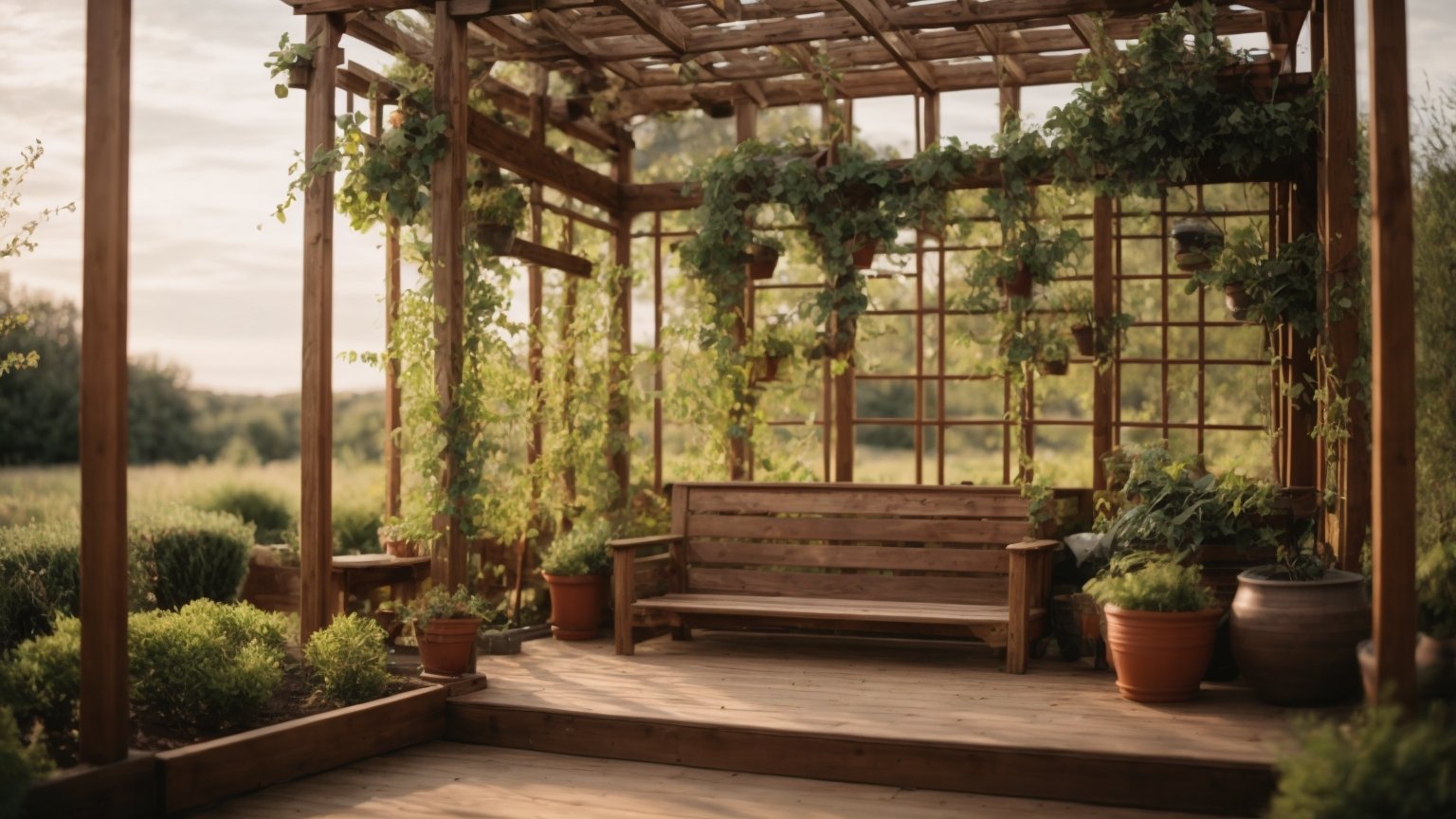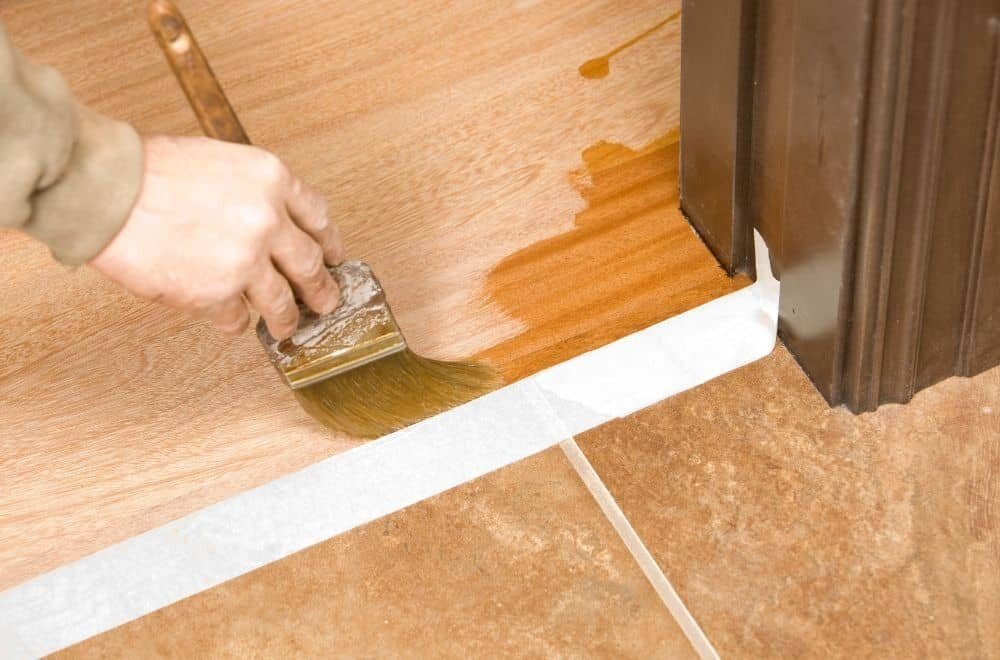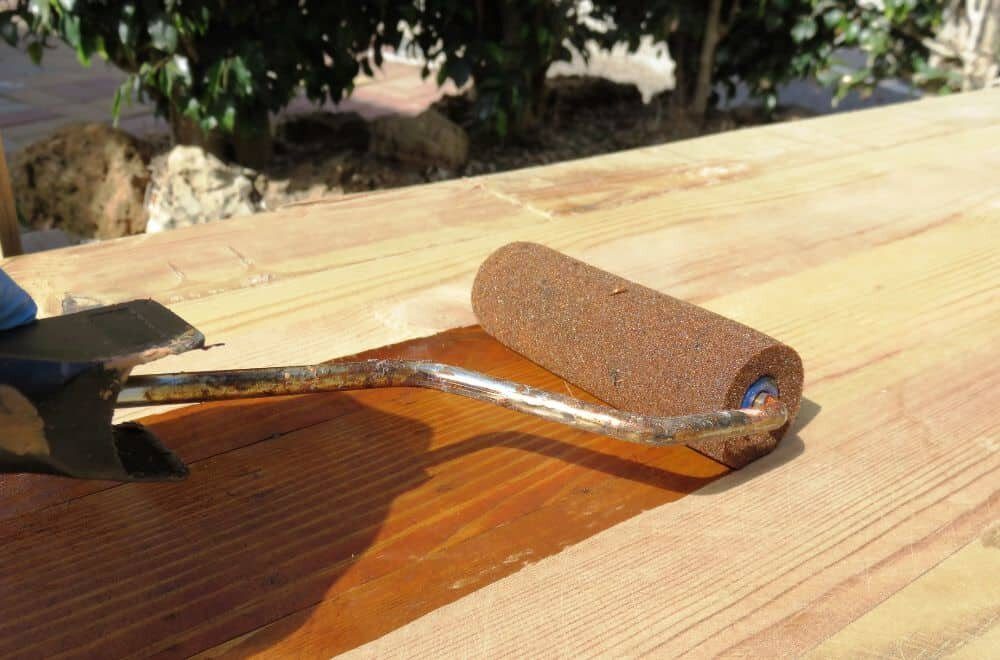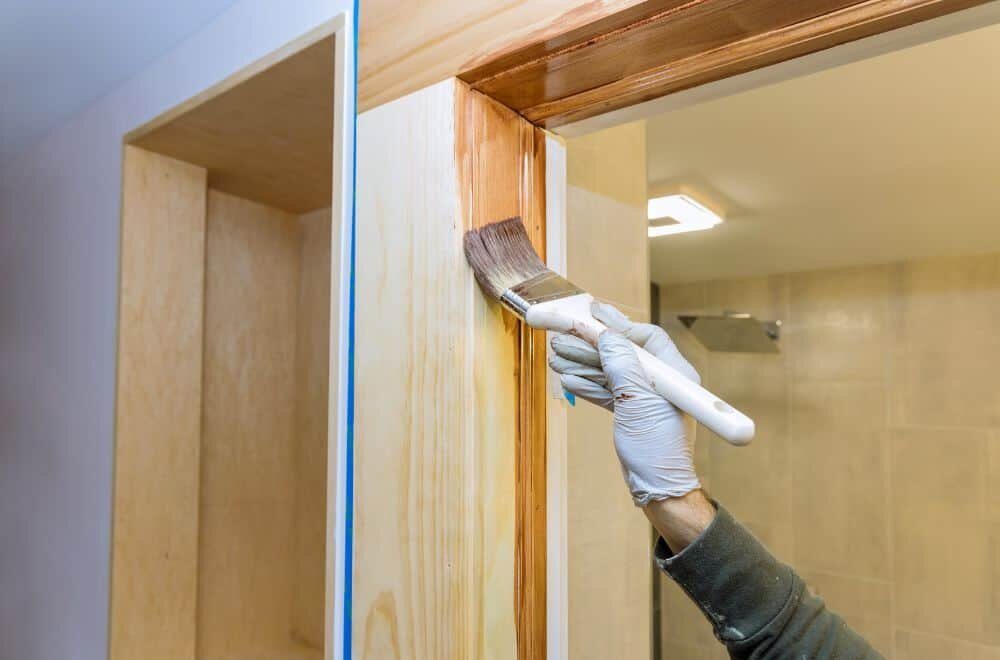Looking to add some height and interest to your garden? A wooden trellis is a great way to support climbing plants and create a beautiful focal point in your outdoor space. With a few basic tools and materials, building a wooden trellis can be a fun and rewarding DIY project.
When it comes to building a wooden trellis, there are a variety of designs and styles to choose from. Some trellises are designed to stand alone, while others can be attached to a wall or fence. You can also choose from a range of materials, including cedar, pine, and redwood, depending on your budget and desired aesthetic. Whether you’re a seasoned woodworker or a beginner, building a wooden trellis is a project that can be customized to fit your skill level and design preferences.
In this article, we’ll walk you through the steps to build a basic wooden trellis, as well as provide some inspiration for more advanced designs. From choosing the right materials to adding decorative touches, we’ll cover everything you need to know to create a beautiful and functional trellis for your garden. So grab your tools and let’s get started!
Understanding the Basic Design of a Wooden Trellis
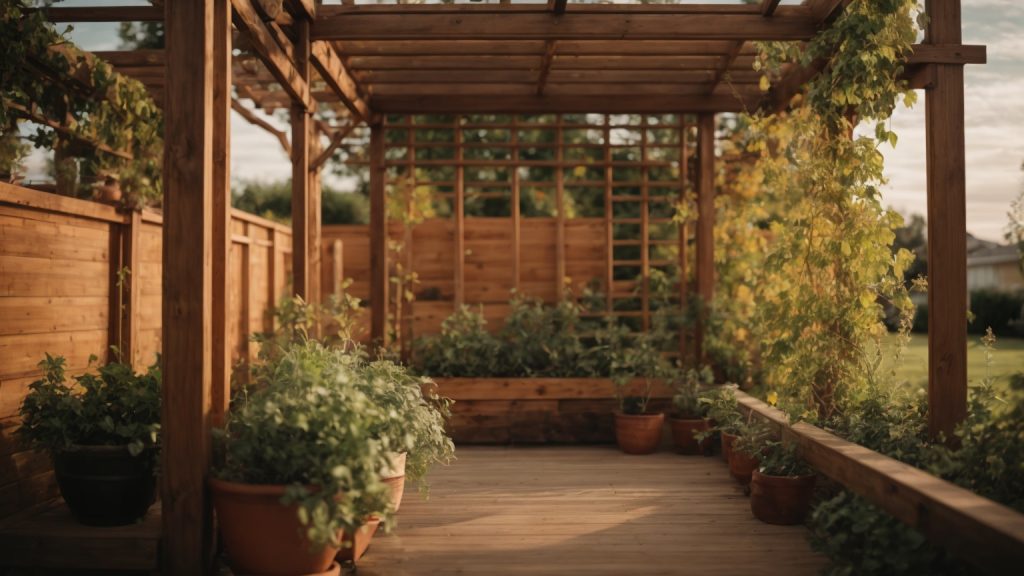
If you’re looking to add a touch of elegance to your garden or outdoor space, a wooden trellis is a perfect addition. Not only do they provide a beautiful aesthetic, but they also serve a functional purpose as support for climbing plants. In this section, we’ll go over the basic design of a wooden trellis, including the types of wooden trellis and key components.
Types of Wooden Trellis
There are several types of wooden trellises that you can choose from depending on your preference and the plants you are looking to support. Here are a few common types:
- Lattice trellis: This type of trellis features a crisscross pattern and is perfect for climbing plants like ivy or roses.
- Fan trellis: This trellis has a fan-like shape and is ideal for training climbing plants against a wall or fence.
- Obelisk trellis: This trellis is a tall, pyramid-shaped structure that is perfect for supporting climbing plants like clematis or morning glory.
Key Components of a Wooden Trellis
Regardless of the type of wooden trellis you choose, there are some key components that all trellises should have. Here are the basic components of a wooden trellis:
- Frame: The frame is the backbone of the trellis and provides the structure that supports the climbing plants. The frame can be made from a variety of materials, but wood is the most common.
- Lattice: The lattice is the crisscross pattern that provides the climbing plants with support. The lattice can be made from wood or other materials like wire or plastic.
- Posts: The posts are the vertical supports that hold the trellis in place. The number of posts you need will depend on the size of your trellis and the weight of the climbing plants you plan to support.
- Crosspieces: Crosspieces are horizontal pieces of wood that connect the posts and provide additional support for the lattice.
By understanding the basic design of a wooden trellis, you can create a beautiful and functional addition to your outdoor space. Whether you choose a lattice, fan, or obelisk trellis, make sure to include all of the key components for a sturdy and reliable structure.
Choosing the Right Materials
When building a wooden trellis, choosing the right materials is crucial to ensure the longevity of your structure. In this section, we’ll discuss the types of wood you can use and the essential tools and equipment you’ll need.
Types of Wood
When selecting wood for your trellis, it’s important to choose a type of wood that is resistant to rot and decay. Cedar and redwood are excellent options due to their natural resistance to water and insects. Pine and spruce are also good choices, but they will need to be treated with a wood preservative to prevent rotting.
Here’s a breakdown of the different types of wood you can use for your trellis:
| Wood Type | Pros | Cons |
|---|---|---|
| Cedar | Naturally resistant to water and insects, lightweight, easy to work with | Expensive |
| Redwood | Naturally resistant to water and insects, durable, attractive | Expensive |
| Pine | Affordable, widely available, easy to work with | Prone to rotting and decay |
| Spruce | Affordable, widely available, easy to work with | Prone to rotting and decay |
Essential Tools and Equipment
To build a wooden trellis, you’ll need a few essential tools and equipment. Here’s a list of what you’ll need:
- Circular saw or handsaw
- Drill
- Screwdriver
- Wood screws
- Wood glue
- Clamps
- Tape measure
- Pencil
- Safety goggles
- Work gloves
It’s important to wear safety goggles and work gloves when working with wood to protect your eyes and hands. Clamps are also helpful to hold pieces of wood in place while you drill and screw them together.
In summary, when building a wooden trellis, it’s important to choose a type of wood that is resistant to rot and decay, such as cedar or redwood. You’ll also need essential tools and equipment, including a circular saw or handsaw, drill, screwdriver, wood screws, wood glue, clamps, tape measure, pencil, safety goggles, and work gloves.
Planning Your Wooden Trellis

Before you start building your wooden trellis, it’s important to plan out the size and shape of the trellis. By doing so, you’ll be able to determine the amount of materials you’ll need and ensure that the finished product will fit your specific needs.
Deciding the Size and Shape
The first step in planning your wooden trellis is to decide the size and shape of the trellis. Consider the following factors:
- The height and width of the plants you’ll be growing on the trellis
- The amount of space you have available for the trellis
- The desired aesthetic of the trellis
Once you have these factors in mind, you can begin to sketch out a rough design of the trellis. You can use graph paper or a computer program to create a blueprint of the trellis.
Creating a Blueprint
Creating a blueprint of your wooden trellis will help you visualize the finished product and ensure that you have all the materials you need before you start building. Here are some tips for creating a blueprint:
- Start by drawing the outline of the trellis, including the height and width.
- Determine the spacing of the slats or lattice work. This will depend on the size of the plants you’ll be growing on the trellis.
- Decide on the type of wood you’ll be using for the trellis and calculate the amount of wood needed for the project.
- Consider adding decorative elements to the trellis, such as finials or decorative cutouts.
Once you have a blueprint of your wooden trellis, you’re ready to start building. By taking the time to plan out your trellis, you’ll be able to create a beautiful and functional addition to your garden.
Building the Wooden Trellis
If you want to build a wooden trellis, you’ll need to prepare the wood, assemble the structure, and secure it in place. Here’s how to do it:
Preparing the Wood
Before you start building your trellis, you’ll need to prepare the wood. You can use any type of wood, but cedar and redwood are popular choices because they’re naturally resistant to rot and insects. Here’s what you’ll need to do:
- Measure and cut your wood to the desired length and width using a saw. Make sure your cuts are straight and accurate.
- Sand the edges of your wood to smooth out any rough spots or splinters.
- Apply a wood preservative or sealant to protect your wood from moisture and decay.
Assembling the Trellis
Once your wood is prepared, you can start assembling your trellis. Here’s how to do it:
- Lay out your pieces of wood on a flat surface. Arrange them in the shape of your trellis, making sure everything lines up evenly.
- Use wood screws or nails to attach your pieces of wood together. Make sure your screws or nails are long enough to penetrate both pieces of wood and hold them securely in place.
- Add any decorative elements, such as lattice or trim, to your trellis.
Securing the Structure
Now that your trellis is assembled, you’ll need to secure it in place. Here’s how to do it:
- Choose a location for your trellis. Make sure it’s in a spot that gets plenty of sunlight and is easily accessible.
- Dig two holes for your trellis posts. The holes should be deep enough to support the height of your trellis and wide enough to accommodate your post holders.
- Place your post holders in the holes and fill them with concrete. Make sure your post holders are level and secure.
- Slide your trellis posts into the post holders and secure them with screws or bolts.
And that’s it! Your wooden trellis is now ready to support your climbing plants and add a beautiful touch to your garden.
Maintaining Your Wooden Trellis
To ensure that your wooden trellis lasts for years to come, it’s important to perform regular maintenance. This includes inspecting your trellis for damage and cleaning it as needed. Here are some tips for maintaining your wooden trellis:
Regular Inspection
It’s important to inspect your wooden trellis regularly to catch any damage early on. This will help prevent further damage and prolong the life of your trellis. Here’s what to look for during your inspection:
- Check for any signs of rot or decay in the wood.
- Look for any loose or missing screws, bolts, or nails.
- Check for any cracks or splits in the wood.
- Look for any signs of insect damage, such as holes or sawdust.
If you notice any damage during your inspection, it’s important to address it as soon as possible to prevent further damage.
Cleaning and Repairs
Cleaning your wooden trellis will help remove dirt, grime, and other debris that can accumulate over time. Here’s how to clean your trellis:
- Use a soft-bristled brush to remove any loose dirt or debris.
- Mix a solution of mild soap and water.
- Dip a clean cloth or sponge into the solution and use it to gently scrub the trellis.
- Rinse the trellis thoroughly with clean water.
- Allow the trellis to dry completely before applying any treatments or making repairs.
If you notice any damage during your inspection, such as rot or cracks, it’s important to make repairs as soon as possible. Here’s how to make repairs to your wooden trellis:
- Use a wood filler to fill any cracks or splits in the wood.
- Sand the repaired area until it’s smooth and level with the surrounding wood.
- Apply a wood sealer or preservative to the repaired area to help protect it from further damage.
By performing regular maintenance on your wooden trellis, you can help ensure that it lasts for years to come.
Customizing Your Wooden Trellis
Once you’ve built your wooden trellis, you can customize it to fit your personal style and garden needs. Here are some ideas to get you started:
Painting and Finishing
One way to customize your trellis is by painting or staining it. This not only adds color and personality to your garden, but also helps protect the wood from weather and insects. Here are some tips for painting and finishing your trellis:
- Choose an exterior-grade paint or stain that is safe for plants and animals.
- Apply a primer before painting to help the paint adhere better and last longer.
- Consider using a clear sealant to protect the wood and add shine.
- Don’t forget to paint or stain the back of the trellis as well to ensure complete protection.
Adding Decorative Elements
Another way to customize your trellis is by adding decorative elements. This can be as simple as hanging a potted plant or as elaborate as attaching metal sculptures. Here are some ideas for adding decorative elements to your trellis:
- Hang string lights or lanterns to create a cozy atmosphere in your garden.
- Attach small shelves or hooks to hold plants, tools, or other decorations.
- Use decorative brackets or corbels to add a touch of elegance to your trellis.
- Install a mirror or stained glass panel to reflect light and add interest.
Remember, the possibilities are endless when it comes to customizing your wooden trellis. Get creative and have fun!
